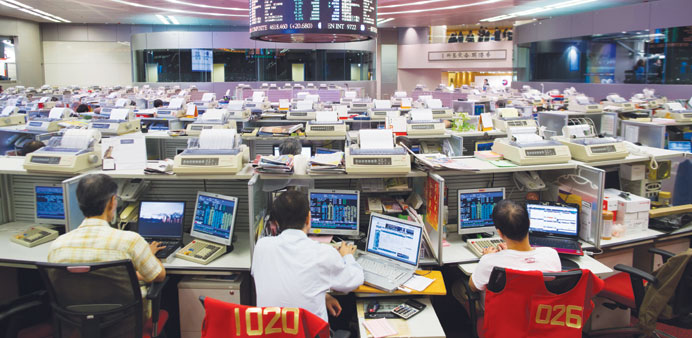Traders work at the Hong Kong Stock Exchange. Hong Kong stocks closed down 272.43 points to 24,193.04 yesterday.
AFP/Tokyo
Hong Kong and Shanghai markets sank in Asian trade yesterday after China set tepid 2015 economic and trade growth targets, while the euro fell to 11-year lows ahead of a key European Central Bank meeting.
Wall Street provided a negative lead again despite an upbeat report on the state of the US economy and another round of healthy private-sector jobs growth.
Hong Kong sank 1.11%, or 272.43 points, to 24,193.04 and Shanghai lost 0.95%, or 31.05 points, to 3,248.48.
Sydney ended flat, edging up 2.57 points to 5,904.16 and Seoul was also virtually unchanged, nudging up 0.09 points to 1,998.38. Tokyo added 0.26%, or 48.24 points, to close at 18,751.84.
In other markets, Singapore closed down 0.59%, or 20.26 points, at 3,395.27; OCBC Bank fell 0.48% to Sg$10.39 while property firm Keppel Land declined 0.44% to Sg$4.52.
Jakarta closed up 0.05%, or 2.89 points, to 5,450.95; palm oil producer Astra Agro Lestari rose 1.25% to 25,975 rupiah, while car maker Astra International fell 0.32% to 7,850 rupiah.
Kuala Lumpur’s main stock index lost 1.07%, or 19.45 points, to close at 1,806.09; Tenaga Nasional dropped 0.54% to 14.64 ringgit, Sime Darby went down 0.21% to 9.32 while British American Tobacco rose 1.11% to 68.96 ringgit.
Bangkok closed down 0.61%, or 9.51 points, to 1,553.33; Bangchak Petroleum fell 4.48% to 32baht, while Siam Commercial Bank gained 3.24% to 175baht.
Taipei fell 0.28%, or 26.64 points, to 9.595.09; Taiwan Semiconductor Manufacturing Co shed 0.33% to Tw$150.0 but smartphone maker HTC rose 0.23% to Tw$88.5.
Wellington eased 0.29%, or 17.31 points, to 5,8456.77; telecom giant Spark was down 1.22% at NZ$3.25 and Air New Zealand slipped 0.17% to NZ$2.95.
Manila closed 0.37%, or 28.79 points, lower at 7,819.04.
China’s National People’s Congress, the rubber-stamp legislature, opened with Premier Li Keqiang setting a growth target for this year of “approximately seven%”, which would be the slowest in 25 years.
The goal, which comes after a 7.4% rise in 2014, also comes as authorities look to set the world’s number two economy on a more sustainable path after decades of breakneck growth.
Authorities also cut their trade growth target for this year to “around 6%” after missing its 7.5% goal in 2014 for the third consecutive year.
Over the past several months a slew of data has indicated a slowdown in the economy, including on manufacturing, inflation and trade.
In a work report, Li said China had been hit as the global economy faced headwinds, adding: “Downward pressure on China’s economy has continued to mount, and we have faced an array of interwoven difficulties and challenges.”
Traders seemed to be unimpressed with news that China will link up the Shenzhen and Hong Kong stock exchanges on a trial basis as part of its financial sector reform. However, Shenzhen’s composite index rose 0.27%, or 4.53 points, to 1,677.77.
The move follows a similar scheme between Hong Kong and Shanghai that started in November. However, while officials trumpeted that as opening up China’s closeted stock markets to the outside world, it has met with tepid demand in both cities.
Regional investors are also keeping an eye on Europe, where the ECB will outline details of its bond-buying programme—known as quantitative easing (QE) – which is aimed at kickstarting the eurozone economy and fending off deflation.
The euro has suffered heavy selling as bank president Mario Draghi prepares to unveil the plan for the €60bn-a-month scheme.
The single currency fell at one point to $1.1028 Thursday, its lowest level since September 2003, before recovering marginally to $1.1058. That compared with $1.1080 late Wednesday in New York.
It was also at ¥132.44 compared with ¥132.63 in New York and much lower than ¥133.68 earlier Wednesday in Asia.
“The combination of deposit rates negative and QE is a very potent one, so it’s very euro negative,” Robin Brooks, chief currency strategist at Goldman Sachs, told Bloomberg news in Sydney.
“We have in our forecasts a very pronounced euro downswing, which is probably the most dollar-bullish forecast in all of our forecasts.” He added that the bank saw the dollar-euro reaching parity by the end of next year before the single currency falls further to 90 US cents by the end of 2017.
The dollar fetched ¥119.83 against ¥119.70 in US trade.
US markets ended lower for a second-straight session as dealers brushed off the Federal Reserve report showing the economy expanding moderately while payrolls company ADP said private firms hired more than 200,000 in February.
The Dow fell 0.58%, the S&P 500 lost 0.44% and the Nasdaq eased 0.26%.
On oil markets US benchmark West Texas Intermediate for April delivery was up 12 cents to $51.65 and Brent crude for April down 21 cents at $60.34.
Gold fetched $1,199.90 against $1,204.12 late Wednesday.



